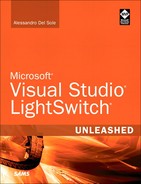Table of Contents
Part I Building Applications with LightSwitch
1 Introducing Visual Studio LightSwitch
A Short History of Microsoft Business Tools
Microsoft Access with Visual Basic for Applications
Microsoft Visual Studio .NET (2002 to 2010)
About Visual Studio LightSwitch
Technologies Used Behind the Scenes
Setting Up the Development Machine
What You Need to Know About Programming
Getting Started with Visual Studio LightSwitch
Creating New Projects and Exploring Solutions
Building, Running, and Debugging Applications
Managing and Arranging Windows
Visual Studio 2010 with LightSwitch
3 Building Data-Centric Applications
The User Interface: Implementing Screens
Testing the Application on the Development Machine
Starting the Application as a Desktop Client
Exporting Data to Microsoft Excel
Running the Application as a 3-Tier Desktop Client
Running the Application in the Web Browser
Default Validation of Business Types
4 Building More-Complex Applications with Relationships and Details Screens
Creating a New LightSwitch Project
Designing Complex Data Sources
Entities That Define Choice Lists
Working with the Money Data Type
More-Complex, Business-Oriented User Interfaces
Running the Application and Entering Data
Editing Data with Editable Grids
Handling Master-Details Relationships with Details Screens
Editing the Screen Navigation Control
Customizing the Look and Feel of Screens
Validation on Master-Details Relationships
Understanding the Validation Model
Writing Custom Validation Rules
Client Validation: Validating Entity Properties
Client and Server Validation: Validating a Single Entity
Data Validation on the Server: Validating Entity Collections
Validation in Master-Details Relationships
For the Experts: Implementing Complex Validation Rules with the .NET Framework
6 Querying, Filtering, and Sorting Data
Applying Filters at the Data Level
Understanding the Query Event Model
Applying Filters at the Screen Level
Basing Queries on Other Queries
7 Customizing Applications with Buttons, COM Automation, and Extensions
Adding Built-In Buttons to the Screen Command Bar
Adding and Managing Custom Buttons
Handling More-Complex Scenarios with COM Interoperability
Downloading, Installing, and Using Extensions
Extensions Types in Visual Studio LightSwitch
Downloading and Installing Extensions
8 Aggregating Data from Different Data Sources
Connecting to SQL Server Databases
Installing the Sample Northwind Database
Creating New Applications on Existing SQL Server Databases
Aggregating Data from Existing Databases into LightSwitch Applications
Database in the Cloud: Connecting to SQL Azure
Establishing Connections to SQL Azure
Connecting LightSwitch Applications to SQL Azure
Collaboration: Working with Lists from SharePoint 2010
Configuring a Vacation Plan Calendar on SharePoint 2010
Extending LightSwitch Applications with SharePoint Data
Part III Securing and Deploying Applications
9 Implementing Authentication and Authorization
Implementing Windows Authentication
Setting Up the Development Environment
Authorization: Settings Permissions
Permission Logic on the User Interface
Creating User Roles and Administering the Application
Implementing Forms Authentication
Publishing Applications with Forms Authentication
Testing the Application with Different Credentials
Permission Elevation on Server Code
10 Deploying LightSwitch Applications
Understanding 2-Tier and 3-Tier Applications
Preparing the Application for Deployment
Specifying the Application Name and Logo
Application Server Configuration
Publishing and Deploying the Application
Configuring the Target Web Server
Remotely Publishing to a Web Server
Creating and Importing Packages into IIS
Preparing Applications to Deployment
Handling Custom Query Events in Code
Handling Screen Events in Code
Launching Screens Programmatically
Opening Screens Without Passing Parameters
Opening Screens by Passing Parameters
12 Dissecting a LightSwitch Application
Applications Architecture and Tiers
Understanding the Data Access and Storage Tiers
Understanding the Presentation Tier
Dissecting LightSwitch Projects
Overview of LightSwitch Solutions
13 Advanced LightSwitch with Visual Studio 2010
Managing the Application Life Cycle with TFS 2010
Connecting to Team Foundation Server
Submitting Projects to Source Control
Creating and Assigning Work Items
Retrieving Specific Project Versions with Version Control
Analyzing the Execution Flow with IntelliTrace
IntelliTrace in Action with LightSwitch
14 Debugging LightSwitch Applications
Advanced Debugging Instrumentation
Breakpoints and Trace Points Unleashed
Showing a Variables Value in the Locals Window
Evaluating Expressions in the Command Window
Understanding the Method Calls Flow in the Call Stack Window
Analyzing Threads with the Threads Window
Understanding Debugger Visualizers
Using Debugger Attributes in Code
Customizing Visual Studio LightSwitch
Customizing Commands and Toolbars
Customizing an Existing Toolbar
Using, Creating, and Managing Reusable Code Snippets
Creating and Using Custom Code Snippets
16 Customizing Applications with Custom Controls
Creating Controls with Visual Studio 2010
Implementing and Aggregating Chart Controls
Binding the User Control to Data and the Screen
Claiming Your Bing Maps Developer Keys
Making Bing Maps Available to LightSwitch
Updating Entities to Support Bing Maps
17 Implementing Printing and Reporting
Using the Office Integration Extension
Creating Emails and Appointments with Microsoft Outlook
Exporting to Microsoft Word and to PDF
Importing and Exporting Data with Microsoft Excel 2010
Using SQL Server Reporting Services
Reporting Extensions from Microsoft Partners
XtraReports from Developer Express
NetAdvantage for LightSwitch from Infragistics
OLAP Extension from Component One
Telerik Reporting for Silverlight
Using Custom Controls for Printing and Reporting
Creating a Visual Report as a User Control
Displaying the Report in the User Interface
18 LightSwitch Extensibility: Themes, Shells, Controls, and Screens
Understanding the Extensibility Model
Creating a New Extensibility Project
Adding a Theme to the Extensibility Project
Editing Themes with Visual Studio 2010
Editing Themes with Expression Blend 4
Creating Extensibility Projects for Custom Shells
Editing the Official Sample from Microsoft
Designing Custom Screen Templates
Implementing the IScreenTemplate Properties
Generating the Screen Content Tree
Screen Templates Tips and Tricks
19 LightSwitch Extensibility: Data and Extension Deployment
Implementing a New Business Type
Implementing the Data Type Definition
Creating and Using Custom Data Sources with WCF RIA Services
The .NET Framework for WCF RIA Services
Creating WCF RIA Services to Work with XML Data
Calling WCF RIA Services from LightSwitch Applications
Calling Stored Procedures Through WCF RIA Services
Deploying Extensions to Others
Preparing the Deployment Manifest
Uploading VSIX Packages to the Visual Studio Gallery
A Installing and Configuring Visual Studio LightSwitch
Installing Visual Studio LightSwitch
Managing the Offline Documentation
Visual Studio LightSwitch Help Website
LightSwitch Video Training on MyVBProf.com
Italian LightSwitch Tips & Tricks Community
Other LightSwitch Blogs and Websites
Document Toolkit for LightSwitch
